NASA Goddard Hosts Third Cross-Agency Workshop on
Artificial Intelligence and Data Science

Participants in the Hinners Auditorium in Building 8 at the NASA Goddard Space Flight Center in Greenbelt, Maryland, engaging with presenters at the 3rd Annual NASA AI and Data Science Workshop. Photos by Sean Keefe, NASA Goddard.
The science and technology of artificial intelligence (AI) and machine learning (ML) are changing rapidly, impacting research across NASA centers, directorates, and projects. Throughout the agency, amazing science is increasingly made possible because of the use of AI tools. Researchers looking into existing datasets are making discoveries about the universe that were not possible only a few years ago. Technologists are improving high-end computing and advancing numerous science instruments, making scientific discovery more efficient and powerful. In the future, the story of AI will be even more complex and nuanced.
To better prepare NASA to leap into that exciting future, NASA’s Science Mission Directorate (SMD) and Engineering and Technology Directorate (ETD) hosted a hybrid, three-day conference, the Third SMD and ETD Workshop on A.I. and Data Science: Leaping Toward Our Future Goals, on March 21–23, 2023 at NASA Goddard Space Flight Center.

A view of NASA Goddard Space Flight Center in Greenbelt, Maryland, looking south from the entry gate on Hubble Road – location of the 3rd Annual NASA AI and Data Science Workshop. NASA photo.
The stated mission of the workshop was to “roll out NASA’s AI/ML strategy for science and engage the science community for feedback on how they can embrace new technologies to implement AI/ML in their workflows and advance their analyses for new scientific discoveries.”
The expected outcomes of the workshop include:
- Documenting opportunities and roadblocks for deeper integration of AI/ML workflows
- Identifying AI gaps and understanding the state of the art
- Providing NASA attendees with guidelines for putting ethical principles into practice
- Developing approaches for open sharing of AI resources and collaboration between NASA centers
The workshop was planned by a steering committee comprised of a dozen representatives from the NASA Science Mission Directorate (SMD) and several NASA centers. Ultimately, the steering committee will deliver a summary report to the SMD at NASA Headquarters for analysis and action.
NASA HQ/NASA Marshall Space Flight Center
- Manil Maskey, Senior Research Scientist, NASA HQ, Leader of the NASA SMD Artificial Intelligence (AI) Team
- Shubha Ranjan, Big Data and Analytics Group Lead at NASA Advanced Supercomputing
- Mark Carroll, Research Scientist, CISTO Data Science Group Lead
- Victoria Da Poian, NASA Visiting Scientist
- Michael Johnson, Chief Technologist, Applied Engineering and Technology Directorate
- James Mackinnon, Computer Engineer, Science Data Processing Branch
- Marlo Maddox, Deputy Director for Institutions, Programs, and Business Management
- Christopher Neigh, Physical Research Scientist, Biospheric Sciences Laboratory
- Barbara Thompson, Research Physicist, Solar Physics Laboratory
- Dan Crichton, Leader, Center for Data Science and Technology; Program Manager, Data Science Program
- Ryan McGranaghan, Data Scientist and Research Scientist
- Ed McLarney, Lead for Transformation Integration and AI/ML, NASA OCIO Transformation & Data Division Activity
Representatives from several NASA centers participated in the hybrid event, along with agency partners from universities and the private sector. There were 125 participants at the workshop, with 75 attending in person at Goddard and 50 attending virtually from various NASA centers and other locations around the country. Just over half the attendees were from NASA, and just under half were comprised of academia, industry, and other agencies. Of the NASA participants, all science divisions were represented at the workshop. 37 speakers presented over the three days of the workshop, including 24 main (up to 45-minute) presenters, with 14 short (10-minute) talks and 5 lightning talks from industry and partners.
The content on each day of the workshop was intended to answer a unique question:
Day 1: “What is the current state/strategy from NASA HQ for using AI/ML to advance science?"
Day 2: “Beyond the platforms, what are the actual tools available to jumpstart AI/ML as a driver of scientific discovery?”
Day 3: “What are the emerging trends, what else is out there, and how do we adopt these at NASA?”
Question of the day: “What is the current state/strategy from NASA HQ for using AI/ML to advance science?"
Day 1 of the workshop began in Hinners Auditorium of NASA Goddard’s Building 8 (and virtually) with introductions by NASA Research Scientist and Goddard Data Science Group (DSG) Lead Mark Carroll, followed by a welcome speech from NASA Goddard Deputy Director for Technology and Research Investments Christyl Johnson.

Left to right: NASA workshop presenters Christyl Johnson, Mark Carroll, Christa Peters-Lidard, and Manil Maskey. NASA photos.
Christa Peters-Lidard, Director of the NASA Goddard Sciences and Exploration Directorate (SED), presented the first technical talk of the day, providing an overview of the state of AI within the SED directorate and showcasing several recent AI use case examples. These included the use of ML at the NASA Goddard Institute for Space Studies (GISS) to greatly improve the calibration of systems such as cloud and radiant energy models; a cross-organizational team estimating crop yields from space with ML; a cross-disciplinary team using ML-informed compression methods to dramatically improve data performance and/or costs associated with data transmission from orbit to ground; physical law-informed neural networks used to find more realistic, accurate science solutions; mapping sheet silicates on near-Earth asteroid Bennu using thermal emission spectra and ML; using supervised ML to predict biotic systems on ocean planets; using deep (DL) learning to discover exoplanets in data from the TESS space telescope; and the notable results of a global research team/project featured on the cover of the March 2 issue of Nature that used DL algorithms to carbon map 10 million trees in African drylands.
Following the SED Director’s overview, 10-minute overviews were presented by representatives of AI in each of the five SED Divisions: Astrophysics, Biological and Physical Sciences, Earth Science, Planetary Science, and Heliophysics.
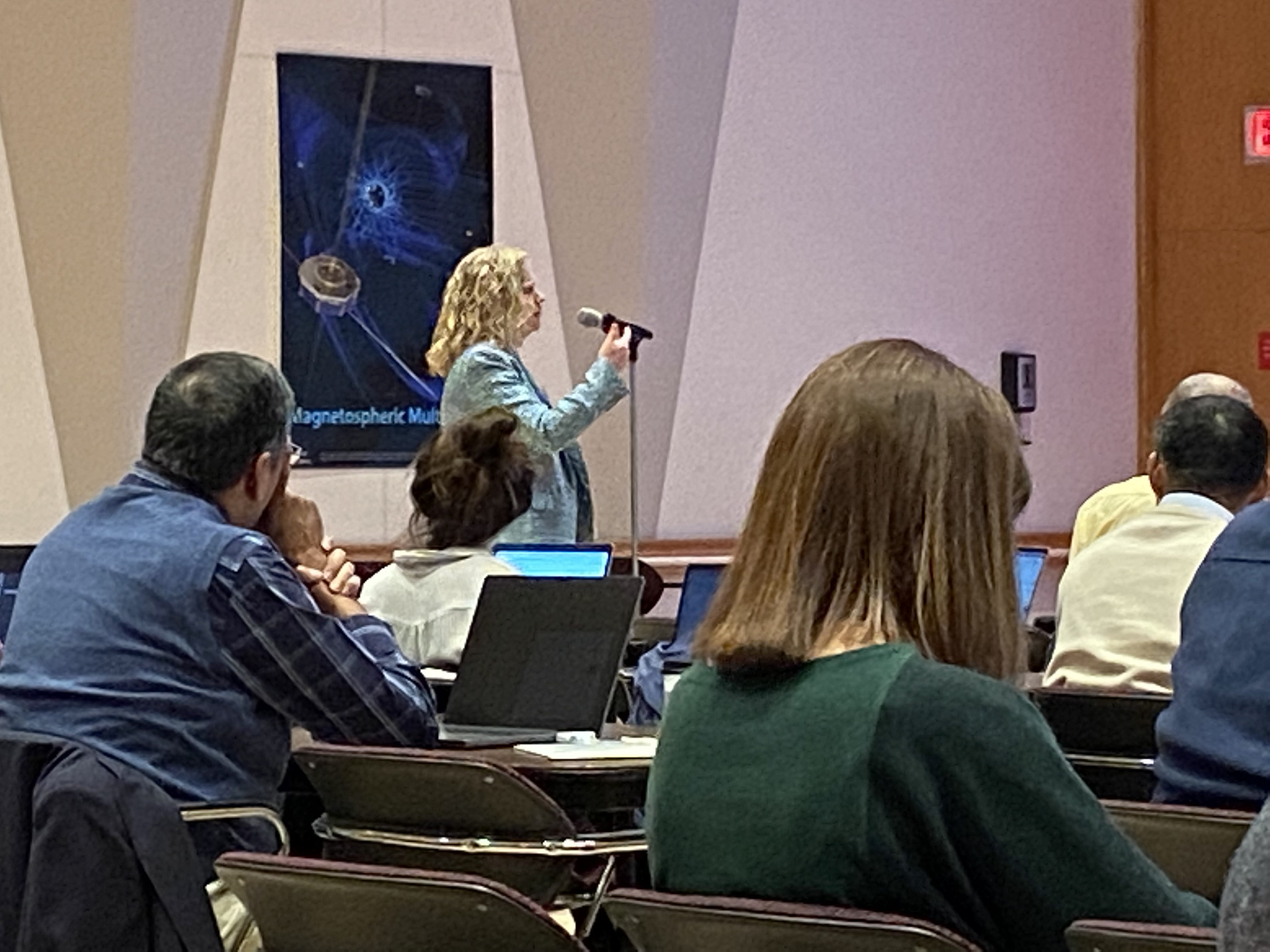
After the division overviews, Laura Carriere takes notes as SED Director Christa Peters-Lidard makes follow-up comments at the microphone. Photo by Sean Keefe, NASA Goddard.
After the SED Division overviews, Manil Maskey from NASA HQ/NASA Marshall presented an overview of the SMD’s Open-Source Science Initiative (OSSI) AI Activities, sharing the goals, recommendations, and timeline of the SMD’s official Strategy for Data and Computing and the related survey results, along with key takeaways, which included:
- Increasing the trustworthiness and reproducibility of AI data and models
- Preparing AI-ready data and sharing training data and models
- Increasing access to computing resources
- Through training and engagement, fostering an inclusive and collaborative community that is able to practice cutting-edge, ethical AI for science
Maskey also covered topics that included planned post-workshop activities and SMD strategies, such as furthering data-centric AI, the generation of training datasets for science, and the ethical and successful application of AI for science using a community-based approach.
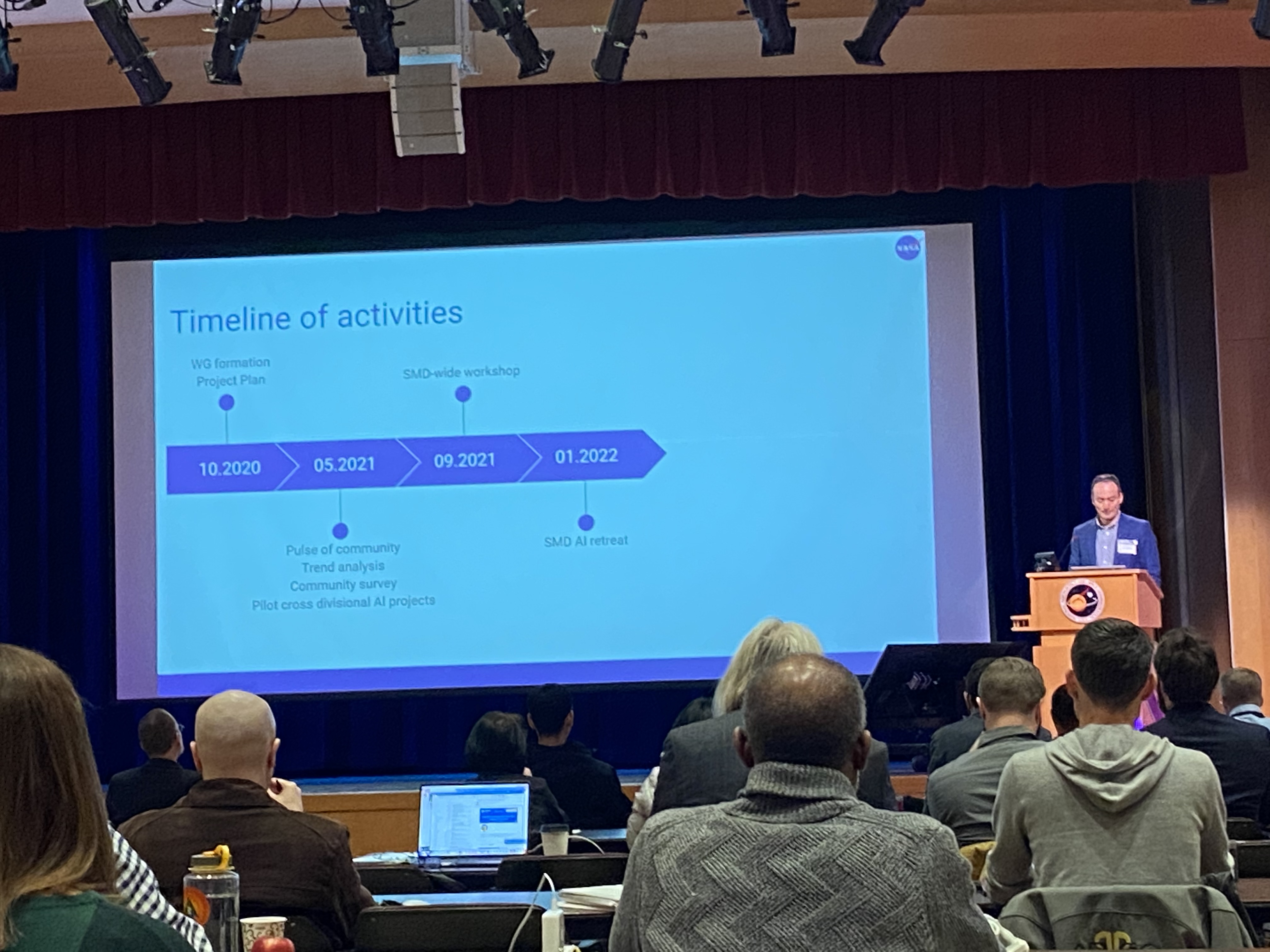
Manil Maskey, Senior Research Scientist and Project Manager at NASA and leader of the NASA Science Mission Directorate's Artificial Intelligence (AI) Team, presents an overview of SMD’s official Strategy for Data and Computing in Building 8 at NASA Goddard. As part of NASA’s open science initiative, Maskey is dedicated to advancing NASA's science research and application with AI. He also leads the advanced concepts team for the Inter-Agency Implementation and Advanced Concepts Team (IMPACT) and the data system evolution project called Visualization, Exploration, and Data Analysis (VEDA), a comprehensive program of activities to enable and support moving science towards openness, including policy adjustments, supporting open-source software, and enabling cyberinfrastructure. Photo by Sean Keefe, NASA Goddard.
After Maskey’s presentation, two representatives from NASA’s High End Computing (HEC) Program -- Laura Carriere, NASA Center for Climate Simulation (NCCS) HPC Lead at NASA Goddard; and Bill Thigpen, Assistant Division Chief of HPC Operations at the NASA Advanced Computing Facility (NAS) at NASA Ames – took turns presenting an overview of the NASA HEC Program’s on-premise resources for AI/ML at each of the two NASA centers.
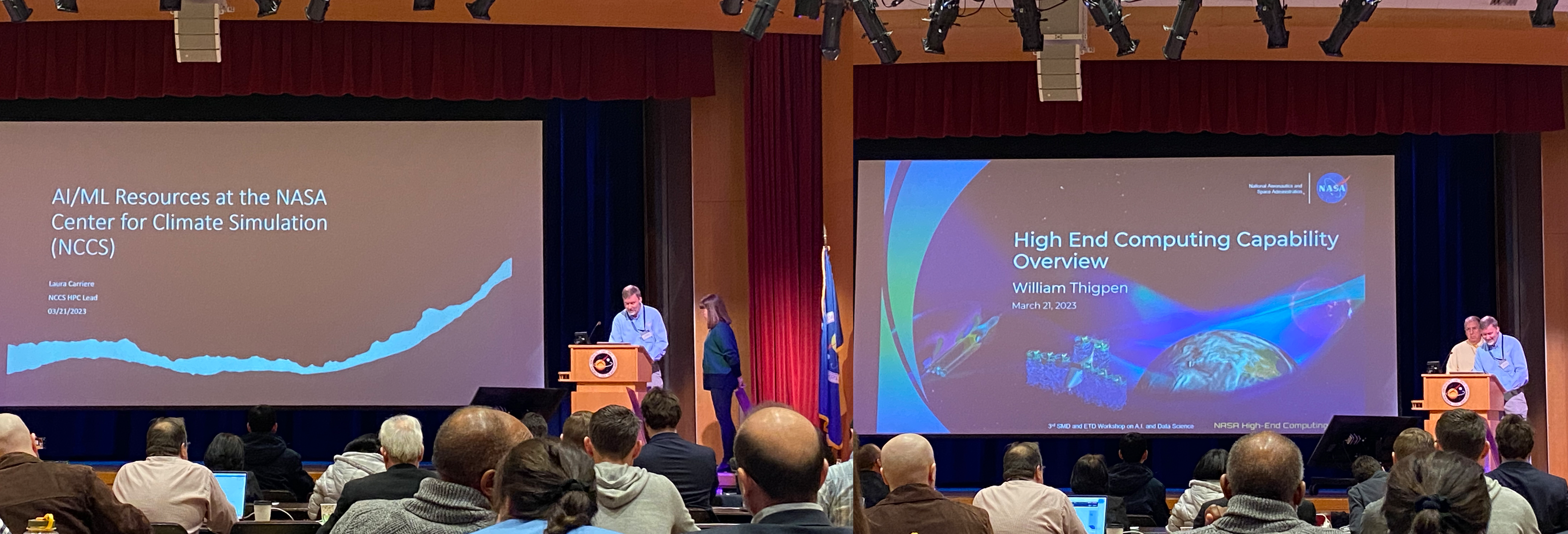
At left, Mark Carroll introduces Laura Carriere, who presented an overview of AI/ML resources at the NCCS facility at NASA Goddard. At right, Mark Carroll introduces Bill Thigpen, who presented an overview of the NAS facility at NASA Ames and its high-end computing resources. Photos by Sean Keefe, NASA Goddard.
Following lunch, three NASA AI experts/early adopters from NASA Goddard presented in-depth summaries of their respective use cases: Brian Powell on using ML in astronomical data; Jacqueline La Moigne on AI for Earth science information systems and digital twins; and Chris Bard on how AI is shaping heliophysics research, followed by brief Q & A sessions.

At left, Brian Powell describes how he uses ML in astronomical data to identify multiple star systems. At right, Chris Bard describes how AI is shaping heliophysics research. Photos by Sean Keefe, NASA Goddard.
In the late afternoon of Day One, a panel of presenters on AI/ML and NASA missions, moderated by Mike Johnson and Victoria Da Poian at NASA Goddard, covered 5 unique topics that included distributed spacecraft autonomy, using ML in future planetary missions, data science for physical science advancement, challenges and opportunities with AI on the edge for spacecraft sensors, and autonomy and automation in resilient mission systems.
Following these presentations, an evening poster session was held in the Building 28 Atrium at NASA Goddard.
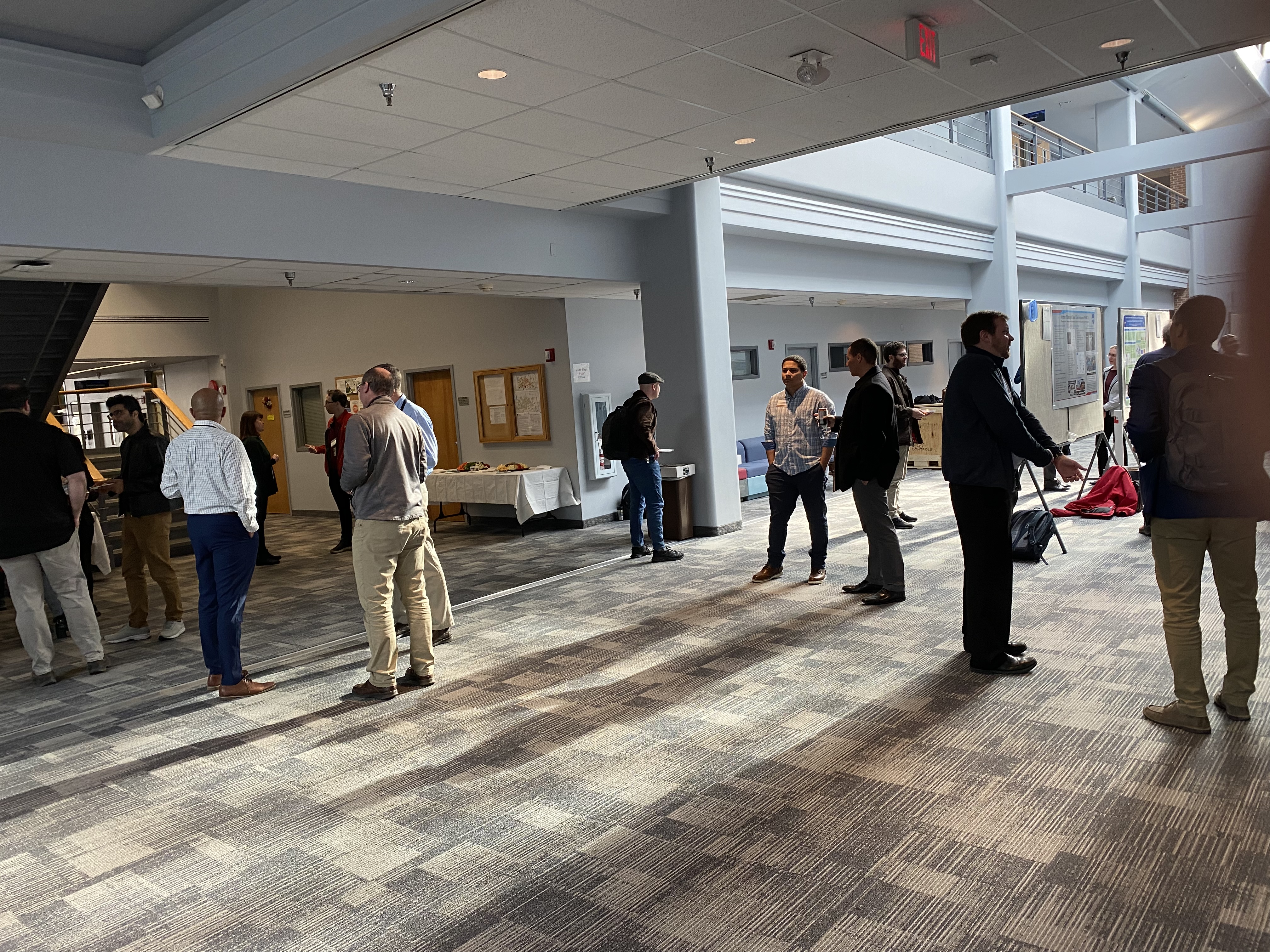
A side view of the Building 28 Atrium at NASA Goddard, location of the evening poster session for the 3rd Annual AI and Data Science workshop. Left to right: Brian Powell and a workshop colleague, along with Marlo Maddox, Laura Carriere, Jack Ireland, Dan Duffy, Mark Carroll, Lucas Brady, Jordan Caraballo-Vega, Christopher Neigh, Chris Bard, Joe Foster, and Manil Maskey discuss AI topics and view posters. Photo by Sean Keefe, NASA Goddard.
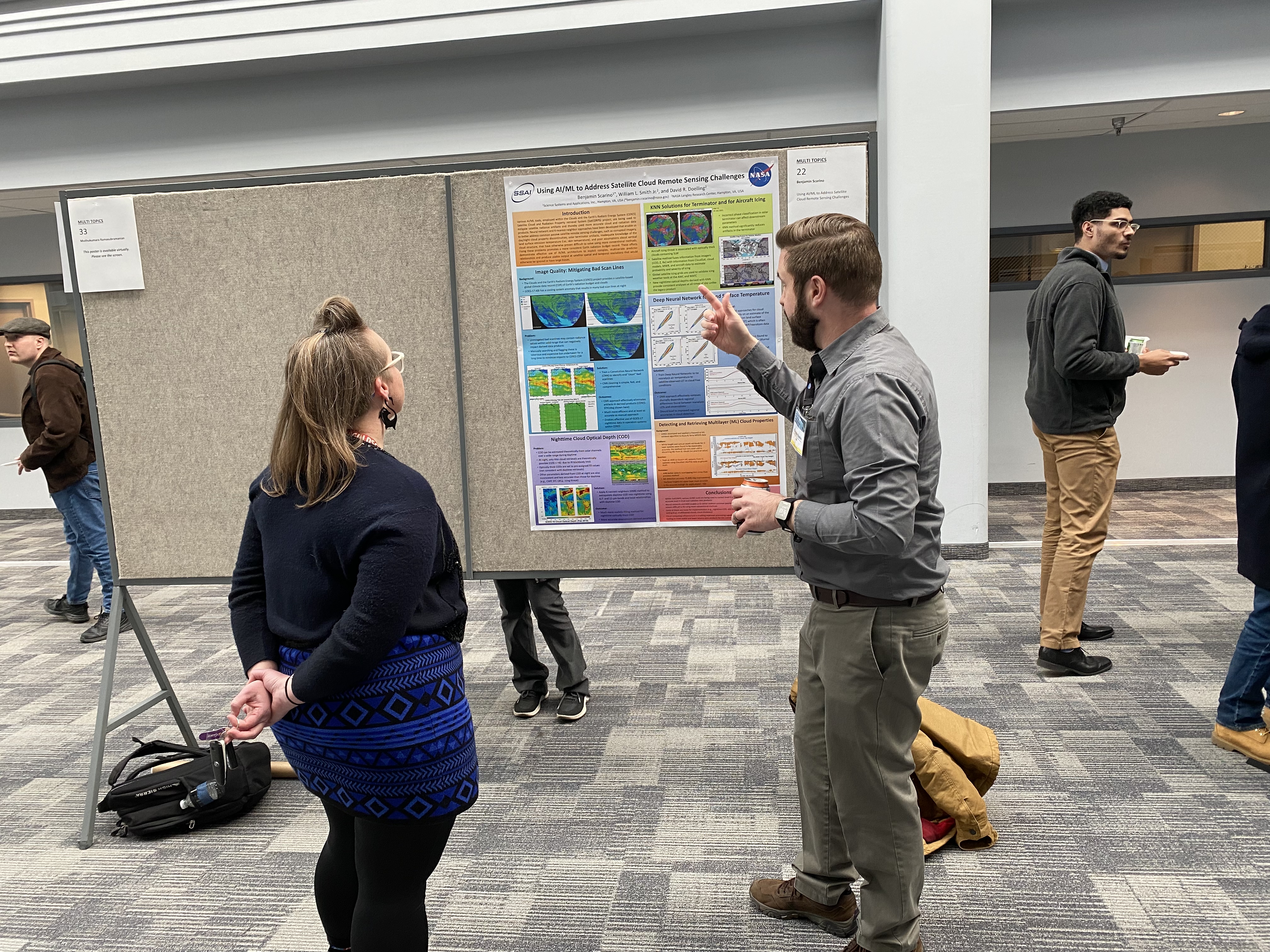
At the workshop’s evening poster session, Ben Scarino, a Senior Research Scientist in the Climate Science Branch of the NASA Langley Research Center Science Directorate is seen discussing his coauthored poster, “Using AI/ML to Address Satellite Cloud Remote Sensing Challenges,” with Bethany Thieling, a Research Scientist in the Planetary Environments Laboratory at NASA Goddard. As part of his work for the Clouds and the Earth’s Radiant Energy System (CERES) Program, Scarino supports the development of global multispectral cloud and surface property retrieval algorithms as well as satellite calibration/validation efforts. Thieling, a Research Scientist in the Planetary Environments Laboratory at NASA Goddard, is an early career innovator who leads machine learning projects focused on the chemical analysis of ocean planets. Photo by Sean Keefe, NASA Goddard.
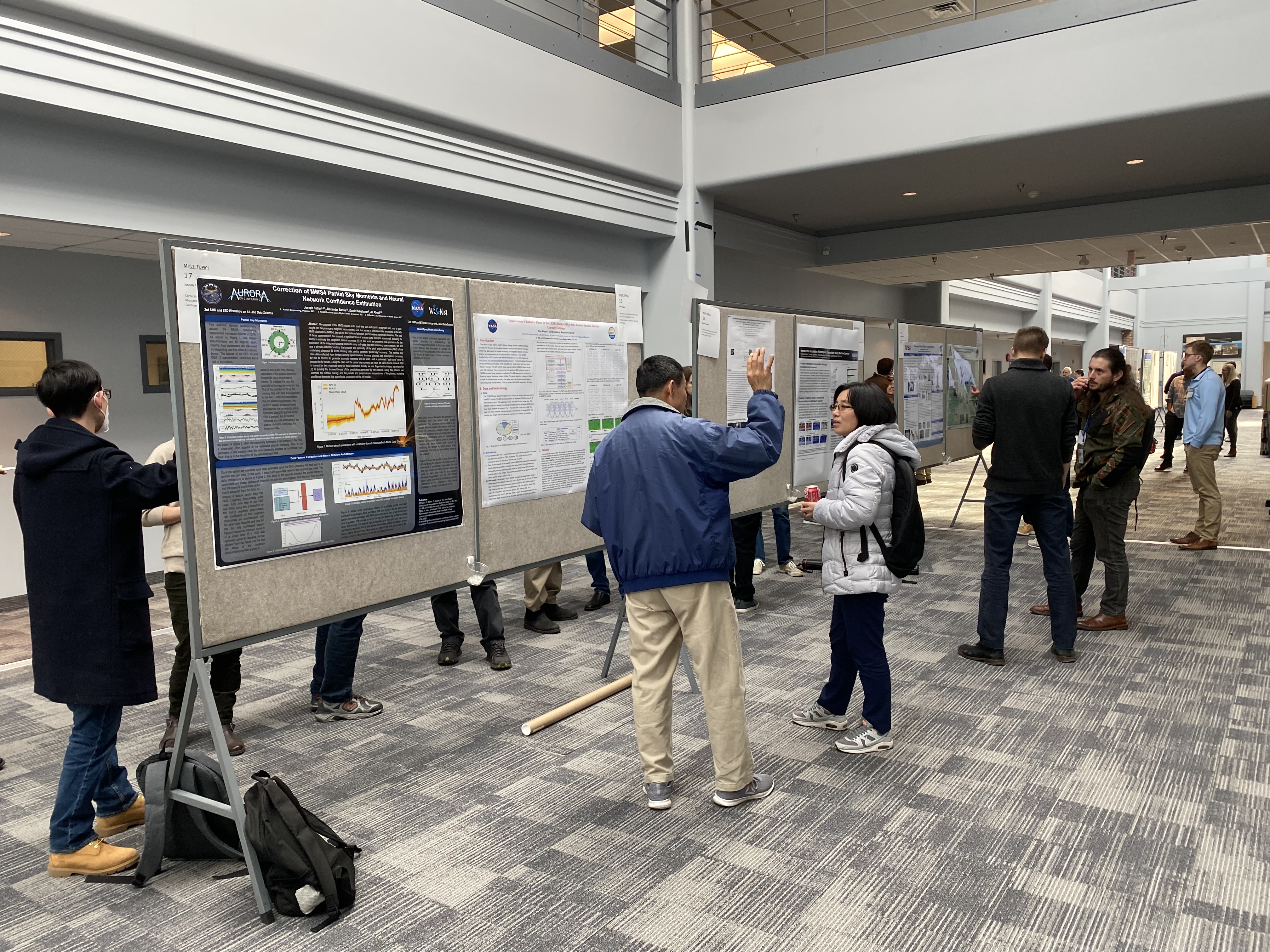
At center, Moguo Sun, Research Scientist at the Atmospheric Science Data Center at NASA Langley is seen discussing his coauthored poster, “Improvement of Radiative Fluxes for the CERES FluxByCldTyp Data Product Based on Machine Learning Techniques,” with a visitor during the workshop’s evening poster session in the Building 28 Atrium at NASA Goddard. To their right, Christoph Keller answers questions from Nicholas LaHaye from JPL about his coauthored poster, “Improve the Simulation of Atmospheric Composition using Machine Learning.” Photo by Sean Keefe, NASA Goddard.
Question of the day: “Beyond the platforms, what are the actual tools available to jumpstart AI/ML as a driver of scientific discovery?”
Day 2 of the workshop began with a 30-minute, virtual presentation on the responsible application of AI by the Senior Director of Data Leadership at the American Geophysical Union, Shelley Stall.
That presentation was followed by a panel on industry and partnerships moderated by NASA Goddard’s Mike Little and Elizabeth Fancher of HQ/Marshall. The five presentations covered NASA Space Act agreements, NASA Small Business Innovation Research (SBIR), NASA Data and Computing Architecture Study, IBM Foundation Models, and Microsoft OpenAI Service.
After a break, there were five industry lightning talks by NASA app users and representatives: Labelbox for data annotation; Cerebras (accelerating scientific discovery with the right AI compute), CFD Research (improving data assimilation in numerical weather prediction of winter cyclones using AI/ML), Emergent Space (ML-Accelerated Grid Environment/MAGE), and Geolabe (estimating groundwater variations with machine learning and InSAR).
Following the lightning talks, there were three presentations on AI/ML tools by researchers from NASA Marshall and NASA JPL: foundation models for science, Rahul Ramachandran (MSFC); knowledge science: search and discovery in NASA data, Kaylin Bugbee (MSFC), and unsupervised instance segmentation and tracking, Nick LaHaye (JPL).
After lunch, five focused topic discussions were held in 3 buildings (and through virtual technology) across the Goddard campus to discuss existing projects and currently funded work, chaired/facilitated by small teams:
- Science enabled and augmented by AI, facilitated by Felix Seidel (JPL)/Christa Peters-Lidard (NASA Goddard)/Michael Kirk (NASA Goddard).
- Models: Physics and AI/ML augmentation, facilitated by Christoph Keller (GSFC)/Brandon Smith (NASA Goddard)/Craig Pelissier (NASA Goddard).
- Community and Societal Impact of AI/ML: Ethics, responsibility, explainability, facilitated by Ed McLarney (NASA Langley)/Barbara Thompson (NASA Goddard).
- The Network of AI Initiatives: Commonality, Culture, and Collaboration across AI/ML groups and communities, facilitated by Ryan McGranaghan (NASA JPL)/Lauren Sanders (NASA Ames).
- The Infrastructure for Data Science – Dan Crichton (NASA JPL)/Shubha Ranjan (NASA Ames).
Question of the day: “What are the emerging trends, what else is out there, and how do we adopt these at NASA?”
Day 3 of the workshop began with a presentation by Amy McGovern, Lloyd G. and Joyce Austin Presidential Professor at the University of Oklahoma's School of Computer Science and School of Meteorology and Director of the NSF AI Institute for Research on Trustworthy AI in Weather, Climate, and Coastal Oceanography (AI2ES), about the AI2ES organization and its mission to develop novel, physically based AI techniques that are demonstrated to be trustworthy and will directly improve prediction, understanding, and communication of high-impact weather and climate hazards, directly improving climate resiliency.
Following McGovern’s presentation, facilitators from each of the five focused topic discussions spent five minutes summarizing the identified gaps and opportunities that were identified.
After these breakout session summaries, Bethany Theiling, a Research Scientist in the Planetary Environments Laboratory at NASA Goddard, presented on developing science autonomy for future missions to ocean worlds.
As the last event of the morning, Dan Chrichton moderated the cross-agency Data Science Group Panel, comprised of Dan Crichton from NASA JPL; Manil Maskey from HQ/NASA Marshall; Nikunj Oza from NASA Ames; Herb Schilling from NASA Glenn Research Center; Ed McLarney from NASA Langley; and Mark Carroll from NASA Goddard.
After lunch, four short (15-minute) presentations were made on a variety of topics that helped answer the question of the day. These included:
Repositories of labeled training data and ML models by Jed Sundwall (Radiant Earth Foundation)
Earth Information Systems by Sujay Kumar (NASA Goddard)
Quantum computing for AI by Lucas Brady (NASA Ames)
NASA AI/ML: Transforming our future by Omar Hatamleh (NASA Goddard/HQ)
At the closing of the third and final day of the workshop, the steering committee challenged participants to make progress using the input and ideas from the 2023 workshop and bring those results to the Fourth NASA Workshop on AI and Data Science hosted at NASA Marshall Space Flight Center and virtually in spring 2024.
IMPRESSIONS AND FUTURE IMPACT
After the 3-day workshop was over and there had been some time to digest and consider the whole experience, several participants, speakers, and steering committee members were asked to provide their unique impressions of the workshop and its impact.
Mark Carroll, NASA Research Scientist and CISTO Data Science Group Lead, observed, “The 3-day event brought together scientists from six different NASA centers to assess the state of AI/ML across NASA science. The community's overwhelming response is that they are ready for sustained efforts to push AI/ML forward and incorporate it into more aspects of their research. There is a great interest in expansion of not only the volume of work, but also the quality, explainability, and ethical application of AI/ML in all aspects of science.”
“NASA Goddard Space Flight Center was pleased to host the 3rd SMD and ETD Workshop on AI and Data Science,” said Christa Peters-Lidard, Director of the NASA Sciences and Exploration Directorate, “and we were grateful for the opportunity to connect with experts at HQ and the other NASA centers.”
“The workshop was an amazing opportunity to learn about the current state and future of AI,” Peters-Lidard continued. “AI has the potential to revolutionize how we enable science across all five science divisions within SMD. From counting carbon in individual trees, to discovering exoplanets, to enabling real-time ionospheric predictions, to finding the building blocks of life on ocean worlds, AI-enabled science and applications are exponentially increasing. I look forward to further discussions about embedding data scientists within all of our NASA science teams, along with the adoption of norms for open science and ethical AI.”
“The workshop was a great opportunity to connect with scientists who can benefit from GPU resources at the NASA Center for Climate Simulation (NCCS) and further their ML-based science,” noted Laura Carriere, High Performance Computing Lead for the NASA Center for Climate Simulation. “We have begun multiple new partnerships and are open to developing even more."
“Participating in the SMD and ETD Workshop on AI has been an invaluable experience,” said Rahul Ramachandran, Senior Research Scientist in NASA's Earth Science Branch at Marshall Space Flight Center and Manager of the Interagency Implementation and Advanced Concepts Team (IMPACT).
“The workshop expanded my understanding of the remarkable AI work taking place within our agency,” noted Ramachandran. “The workshop offered a platform for exchanging insights and best practices, leading to a better understanding of diverse initiatives and breakthroughs in the field. Moreover, this workshop has fostered a vibrant network of passionate practitioners committed to pushing the boundaries of AI.”
"The Goddard Workshop on AI and Data Science was a thought-provoking event,” reflected Shubha Ranjan, Big Data and Analytics Group Lead in the NASA Advanced Supercomputing (NAS) Division at NASA Ames. “Working with experts to gather information on the progress, common issues, and interpreting guidance for carving a future path for enhancing AI capabilities at the agency through highly engaging breakout sessions in areas of science, required infrastructure, and ethics was productive. And with the forward- thinking invited speakers, we all left the workshop with ample food for thought to help plan next steps.”
“I was excited to see projects from other data science groups across NASA,” NASA astrophysicist Chris Bard of NASA’s Geospace Physics Laboratory and Managing Director for the Center for HelioAnalytics, an AI/ML data science community for Heliophysics, said, “especially those who are working on using novel techniques to learn new connections and insights from our data.” Bard continued, “I especially enjoyed the Scientific Understanding from Data Science (SUDS) presentation from JPL, which described using data to more directly develop our answers, rather than simply testing our guesses.”
“Many passionate and distinctive perspectives were offered during the workshop,” Ben Scarino, a Senior Research Scientist in NASA’s Climate Science Branch, noted. “It is rewarding to be engaged with NASA's strategy to embrace and implement AI/ML for science.”
“It was exciting to see and hear about NASA's strategy and future actions to encourage the use of AI, and, more specifically, about ML development for future space missions,” said Data Scientist Victoria Da Poian at NASA’s Planetary Environments Laboratory. “I was happy to hear unique perspectives from a variety of experts from different NASA centers to better integrate data science tools into space science, especially for planetary science missions – my field of interest.”
Da Poian continued, “I really look forward to future opportunities and support from the NASA management to integrate AI and, more precisely, ML applications in missions design workflows, as I believe adopting and developing a data science strategy for future planetary science missions will greatly enhance our capabilities for space exploration.”
Frequent NASA consultant Peter Williams, who attended the event in person to support workshop leads and capture content for the future workshop report, observed, “Hearing firsthand about the work going on across NASA centers, disciplines, domains and with NASA partners was truly inspiring. But hearing about the work ahead for NASA and the opportunities waiting to be embraced, the concrete ideas for next steps – that was even more exciting."
“The SMD AI workshop helped enhance the community's understanding of AI and its applications in the SMD,” Manil Maskey, leader of the NASA Science Mission Directorate's Artificial Intelligence (AI) Team, observed. “The event facilitated valuable networking opportunities, fostered potential future collaborations, and promoted a culture of knowledge sharing. It served as a platform to discuss future trends, the current state of the art, and the challenges of its usage within SMD. Lastly,” Maskey remarked, “it informed participants of the various AI resources and tools available for SMD, equipping them with potential resources for future work.”
“Ultimately,” Maskey went on to explain, “the outcomes of the March workshop will be used to guide some of the steering committee’s future activities. We will continue to seek additional input from the research community through meetings, retreats, workshops, solicitations, requests for information (RFIs), and webinars. The team will also create focused, NASA Science Mission Directorate (SMD)-wide working groups to foster collaboration on leveraging AI technologies for common applications.”
RELATED LINKS
NASA AI Workshops:
- The Third SMD and ETD Workshop on AI and Data Science, 2023, hybrid, hosted onsite at NASA Goddard.
Posters: https://ai-ml-meeting-2023.ipostersessions.com/Default.aspx?s=ai_ml_23_g... - The Second AI and Data Science Workshop for Earth and Space Sciences, 2021, hosted online by NASA JPL.
- The First NASA Goddard Workshop on Artificial Intelligence, 2018, hosted onsite at NASA Goddard.
Sean Keefe, NASA Goddard Space Flight Center
May 19, 2023


